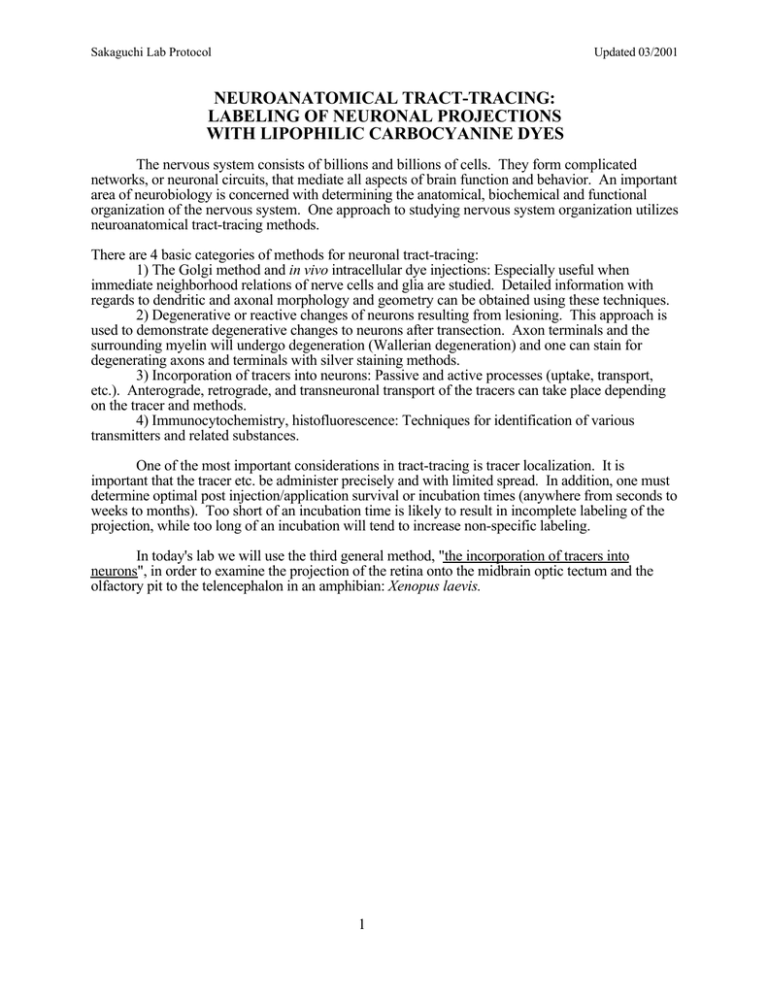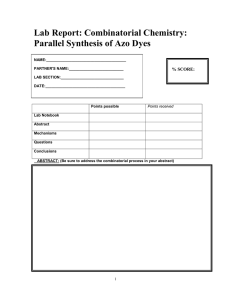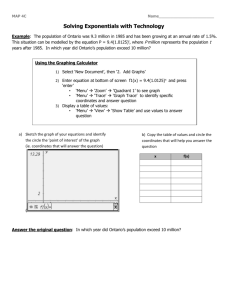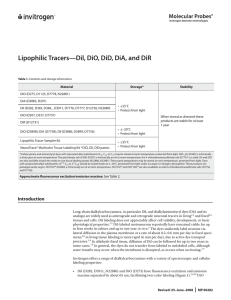NEUROANATOMICAL TRACT-TRACING: LABELING OF NEURONAL PROJECTIONS WITH LIPOPHILIC CARBOCYANINE DYES
advertisement

Sakaguchi Lab Protocol Updated 03/2001 NEUROANATOMICAL TRACT-TRACING: LABELING OF NEURONAL PROJECTIONS WITH LIPOPHILIC CARBOCYANINE DYES The nervous system consists of billions and billions of cells. They form complicated networks, or neuronal circuits, that mediate all aspects of brain function and behavior. An important area of neurobiology is concerned with determining the anatomical, biochemical and functional organization of the nervous system. One approach to studying nervous system organization utilizes neuroanatomical tract-tracing methods. There are 4 basic categories of methods for neuronal tract-tracing: 1) The Golgi method and in vivo intracellular dye injections: Especially useful when immediate neighborhood relations of nerve cells and glia are studied. Detailed information with regards to dendritic and axonal morphology and geometry can be obtained using these techniques. 2) Degenerative or reactive changes of neurons resulting from lesioning. This approach is used to demonstrate degenerative changes to neurons after transection. Axon terminals and the surrounding myelin will undergo degeneration (Wallerian degeneration) and one can stain for degenerating axons and terminals with silver staining methods. 3) Incorporation of tracers into neurons: Passive and active processes (uptake, transport, etc.). Anterograde, retrograde, and transneuronal transport of the tracers can take place depending on the tracer and methods. 4) Immunocytochemistry, histofluorescence: Techniques for identification of various transmitters and related substances. One of the most important considerations in tract-tracing is tracer localization. It is important that the tracer etc. be administer precisely and with limited spread. In addition, one must determine optimal post injection/application survival or incubation times (anywhere from seconds to weeks to months). Too short of an incubation time is likely to result in incomplete labeling of the projection, while too long of an incubation will tend to increase non-specific labeling. In today's lab we will use the third general method, "the incorporation of tracers into neurons", in order to examine the projection of the retina onto the midbrain optic tectum and the olfactory pit to the telencephalon in an amphibian: Xenopus laevis. 1 Sakaguchi Lab Protocol Updated 03/2001 Neuronal tract-tracing using lipophilic carbocyanine dyes General features: There are several different versions of the carbocyanine dyes. They can be obtained from Molecular probes, Inc., Eugene, OR. (very useful pdf file: http://www.probes.com/media/pis/mp00282.pdf) (MSDS information: http://www.probes.com/servlets/msds?item=282) DiI: 1,1',di-octadecyl-3,3,3'3'-tetramethylindocarbocyanine perchlorate (fluoresces red-RITC filter set). DiO: 3,3'-dioladecyloxacarbocyanine perchlorate (fluoresces orange/yellow- FITC filter set). Application: Labeling by passive incubation or direct injection. Can be used on live or fixed tissue (aldehyde fixed tissue). Fixed tissue: stain limited to cell surface, beautiful morphology. Live tissue: stain mainly localized in intracellular vesicles. Non-cytotoxic. Carbocyanine dyes, fluorescent lipophilic dyes used primarily for optical recordings of membrane voltage and for studies of membrane fluidity, have been shown to provide intense, longlasting staining of live neurons in vivo and in vitro (Godemont et al., 1987). DiI, DiO, and DiA are brightly fluorescent, can label the plasma membrane with high specificity and are not cytotoxic. They are available in different colors and are therefore useful for multicolored labeling studies. Their chemical structure and highly lipophilic character facilitates their insertion in the lipid fraction of the plasma membrane of intact cells where they diffuse freely. When applied to live brain tissue or near peripheral endings they are taken up by axons or axon terminals and transported back to cell bodies. They can also be incorporated by cell bodies and move anterogradely to axon terminals. In addition, these dyes can also be used to label neurons in tissue that has been previously fixed in aldehyde fixatives. Neuronal processes and somata can be labeled along considerable distances in both the retrograde and anterograde directions. The staining is smooth and clear, rivaling intracellular injections of Lucifer Yellow or HRP. The appearance and timecourse of progression of the dye along axons suggest that the staining in fixed tissues occurs due to a process of diffusion of the dye along the plasma membrane of cells, whereas in living tissue the stain is mainly present in intracellular vesicles. Diffusion of DiI has been followed in aldehydefixed tissue over a period of two years. DiI has been used to label motorneurons in vivo, and the cells remained viable for one year, they were reliably identified both in situ and later in culture. Following photo-oxidation in the presence of diaminobenzidine, its location is detectable by electron microscopy. The technique has a number of advantages. The resolution of fine processes is similar to that seen using intracellular injections and appears better than that achieved by Golgi methods or by intra-axonal transport of other tracer substances. Since the method is based on the use of fixed tissue it is also very convenient. A number of alternative versions of DiI and DiO are available. These are diunsaturated linoleyl DiI and DiO (Fast DiI and Fast DiO). These have been shown to diffuse approximately 50% faster than DiI and DiO. See the Molecular Probes website for additional probes and information. Materials: Animals/specimen Dissecting microscope with illuminator Dissecting dish (Sylgard or wax) MS-222 anesthetic Large-bore pipette or spoon for transferring of specimen Small pins bent into the shape of a "7" and "U" Micro-pin probe (tiny, pins stuck into the end of a small wooden applicator stick) Sharp forceps 2 Sakaguchi Lab Protocol Updated 03/2001 DiI (1,1-dilinoleyl-3,3,3',3'-tetramethylindocarbocyanine, perchlorate): from Molecular Probes, Inc., Eugene, OR (Cat. # D-3899). DiO (3,3'-dilinoleyloxacarboxyanine, perchlorate): (Cat. # D-3898). PBS: phosphate buffered saline 4% Paraformaldehyde in 0.1M PO4 buffer Kimwipes Waste beaker for solutions Glass microscope slides and coverslips Clear finger nail poish Mounting medium: Gelmount Glass vials with screw/snap caps Pipettes and bulbs Material Safety Data Sheets (MSDS) Fluorescence microscope with appropriate filter sets 1) Anesthetize the tadpoles in MS-222, a local anesthetic. Fix the animals in 4% Paraformaldehyde in 0.1 M PO 4 buffer for 1-2 hours at room temperature or overnight at 4o C. Glutaraldehyde fixed tissue is not suitable for observation in wholemounts because it produces intense background fluorescence. Note: We have already taken care of this step for you. However, be careful in handling the fixative and fixed tadpoles, the paraformaldehyde is toxic. Pour excess paraformaldehyde into the waste containers, not down the drains. Wash your hands if you feel that you may have come into contact with the paraformaldehyde. 2) Using the wide end of a pipette (or a very small spoon shaped scoop), transfer the tadpoles to a Sylgard dissecting dish and add PBS. Immobilize animal using "micro-pins" bent into the shape of a "7" and "U" (see Fig. 1). If you are applying dye to younger larvae or embryos, they should be immobilized on their side using the "7" pins. Do not actually place the pins through the embryos/larvae, but simply immobilize the specimen. Labeling the retinal projection: 3) Using a "micro-pin probe" or sharp forceps, carefully remove the skin overlying the eye (Fig. 1). The eye is held in position by ocular muscles and the optic nerve, and thus, it is very unstable (i.e. wobbly) so be careful or you will pluck the eyeball out. 4) Carefully make a small cut or tear in the sclera surrounding the eye, trying not to damage the eyes. Remove any lens cells and vitreous that may remain in the eyecup, trying not to damage the eyes. 5) At this point you may find it easier to remove the buffer/ringers solution from the dissecting dish. Using Kimwipes, carefully soak up excess buffer from around the specimen (especially the structure you will be labeling). Be careful not to damage the tissue. Also, keep the tissue damp, do not let the tissue dry out. 6) Under visual control (i.e., using a dissecting microscope) use a micro-pin probe to scrap a few crystals of DiI from the wall of the eppendorf tube containing the dye. Be sure to use separate probes for each dye that you use. (General rule of thumb, if you can see the dye crystals with your naked eye, you have too much dye on the pin probe). Place a few dye crystals into the eyecup (If there is excess buffer surrounding the specimen, some of the dye will immediately disperse into the solution, but most of it should reach the eye). Gently push the dye crystals into the eyecup. It may 3 Sakaguchi Lab Protocol Updated 03/2001 require multiple attempts to ensure that the dye remains in the eye. Excess or stray dye contacting other tissues will dramatically increase nonspecific or background labeling. 7) Repeat these procedures for the other eye using the DiO. Figure 1. Xenopus tadpole. 4 Sakaguchi Lab Protocol Updated 03/2001 Labeling the olfactory projection in tadpoles: 8) Using a micro-pin probe, scrape the inner surface of the olfactory pits. This will expose and damage the dendrites of the sensory neurons and facilitate labeling with the dyes. 9) Using a micro-pin probe, scrape a small quantity (a clump a bit bigger than the tip of the pin) of dye from the eppendorf tube and insert the dye into the olfactory pit. As you withdraw the probe, make certain that the dye stays in the pit. It may require multiple attempts to ensure that the dye remains in the pit. Excess or stray dye contacting other tissues will dramatically increase nonspecific or background labeling. 10) Repeat these procedures for the other olfactory pit using the DiO. 11) Transfer the dye labeled tadpoles back into fix and incubate in the dark at room temperature (make sure you label the vials and note which dye was placed where). Each group should attempt 4-8 preparations. Next week: 12) After the appropriate incubation period (3 days - 2 weeks, depending on the age and size of your specimen) transfer the tadpoles into your dissecting dish and carefully dissect-out the brains in PBS. (Dispose of the fix in the labeled waste container.). See Figure 2. Figure 2. Procedure for wholemounting of Xenopus larval/tadpole CNS. 13) Carefully rinse the tissue in PBS, you are now ready to mount your preparations as wholemounts. 14) Use spacers to prevent crushing the dissected brains. To make the spacers, place 1 coverslip on top of one end of the glass microscope slide (a small dab of Gelmount will act as glue to prevent the glass coverslip from sliding around). Repeat and place another coverslip towards the other end of the slide, leaving ~5 mm space between the two spacers (Fig. 2). As necessary, repeat this procedure stacking coverslips one on top of the other to create the spacers. 15) Mount in low autofluorescence mounting media such as Gelmount. Place 2 drops of the Gelmount between the spacers (minimize air-bubbles in the mounting medium). Using a Pasteur pipette, orient the brain dorsal side-up and place a coverslip on top of 5 Sakaguchi Lab Protocol Updated 03/2001 the brain. Do not let the coverslip "plop" down, but carefully set one end of the coverslip down across the spacers and gradually, but quickly, lay the coverslip down. If some shifting of the brains occurs, gently reorient the brains by carefully sliding the coverslip (Fig. 2). 16) After excess Gelmount has been removed, and the mounted preparations are allowed to begin hardening, use fingernail polish to seal the edges of the coverglass to prevent desiccation. We will examine the dye-labeled preparations on a fluorescence microscope. References: Godement, P. et al., 1987. A study in developing visual systems with a new method of staining neurones and their processes in fixed tissue. Development 101:697-713. Neuroanatomical Tract-Tracing Methods 2 (eds. L. Heimer and L. Zaborszky). 1989 Plenum Press, New York. 6





